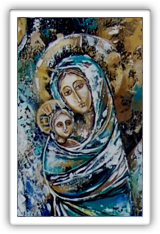|
|
Comprehending Medjugorje : Original Documents And Conversations with Arnaud Dumouch
The Virgin Mary
Reference (French Edition) :
Daria Klanac, Comprendre Medjugorje : Regard historique et théologique, avec la collaboration du théologien Arnaud Dumouch, Informativni centar Mir, Medjugorje, en coédition avec les Éditions Sakramento, Paris, 2012, 2e éd. (1re éd. 2008, ISBN 978-2-915380-19-4 & 978-9958-36017-6), entretien avec le théologien Arnaud Dumouch, pages 197 à 198.
English Translation by Duško Čondić
The Virgin Mary
Daria Klanac : It angers some that Mary seems to speak too much in Medjugorje, while in the entire Gospels, she barely spoke a few sentences. It she too much of a “chatterbox” as some seem to think?
Arnaud Dumouch : That is hardly an argument that could be used to either accept or reject the validity of the apparitions. If the apparitions are recognized one day, both the theologians and the saints will say that Mary was close and familiar in Medjugorje as she was with Jesus when he was a child.
If the apparitions are condemned, they will stress the argument that was cited above. In short, none of this is determinative.
D. Klanac : Still others feel that people “adore” her even though she continues to unceasingly say: “Adore my son Jesus!” It is true; there is much love for Jesus and Mary in Medjugorje, however, by no means in the same way. We implore Mary, and she prays along with us and we with her. We only adore Jesus. When we adore, she is there with us.
A. Dumouch : This is a classical argument used by those who, in general, think that the cult of honoring and venerating (dulia), Mary that is fostered in the Catholic and Orthodox Churches towards the Mother of God and the saints represents some sort of diminution of glory towards God. The Catholic and Orthodox Churches never accepted such observations that seem to be near and dear in Protestant circles. They did so for these reasons:
1. Only God is the object of the cult of adoration (latria). The Mother of God and the saints are the subjects of the cult of reverence (dulia), of the sort that is prescribed in the Old Testament towards one’s parents (Ex 20:12): “Honor thy father and mother so that you will have a long life on Earth that Yahweh, your God, granted unto you.”
2. The Catholic Faith is well aware that Jesus is the true God who, in His holy human manhood, does not exhaust the image of God. In order for us to understand God as well as we can on this Earth, we may not bifurcate the image that is present in “man and woman” as admonished in the biblical text: (Gen 1:27): “In His own image God made man, in the image of God He created them male and female, He created them.
Hence, from the time of the gifting of the Miraculous Medal in Bac Street, the Divine heart of Jesus and the human heart of Mary are united and of the same size, which, in fact, is exactly this very mystery. In other words, so as to be able to contemplate God as best we can in this world, we must look at the male person of Jesus (strength and wisdom) and the female person of Mary (gentleness and stillness).
3. The Church believes that Heaven is a true family of love (where the Divine husband and his beloved live in merciful love that includes equal rights and initiative), and not only, as some Protestants seem to think, a Kingdom that has its King and His children who have inferior rights. The Catholic Church, then, believes that the Mother of God, the one betroth to the Holy Trinity, derives complete confidence to such a degree that she can draw graces to her heart’s content so that she can then gift them to men according to her own will: this is because the will of Mary and that of the saints is the same as that of the Holy Trinity. That is what Holy Writ tells us (John 14:12): “Amen, Amen, I say to you. He who believes in me will do works that I do. He will do greater works than this since I go to the Father.” Or this passage (Mt 25:21): “Good and faithful servant! You were faithful over little things, hence I will appoint you over great things.”
